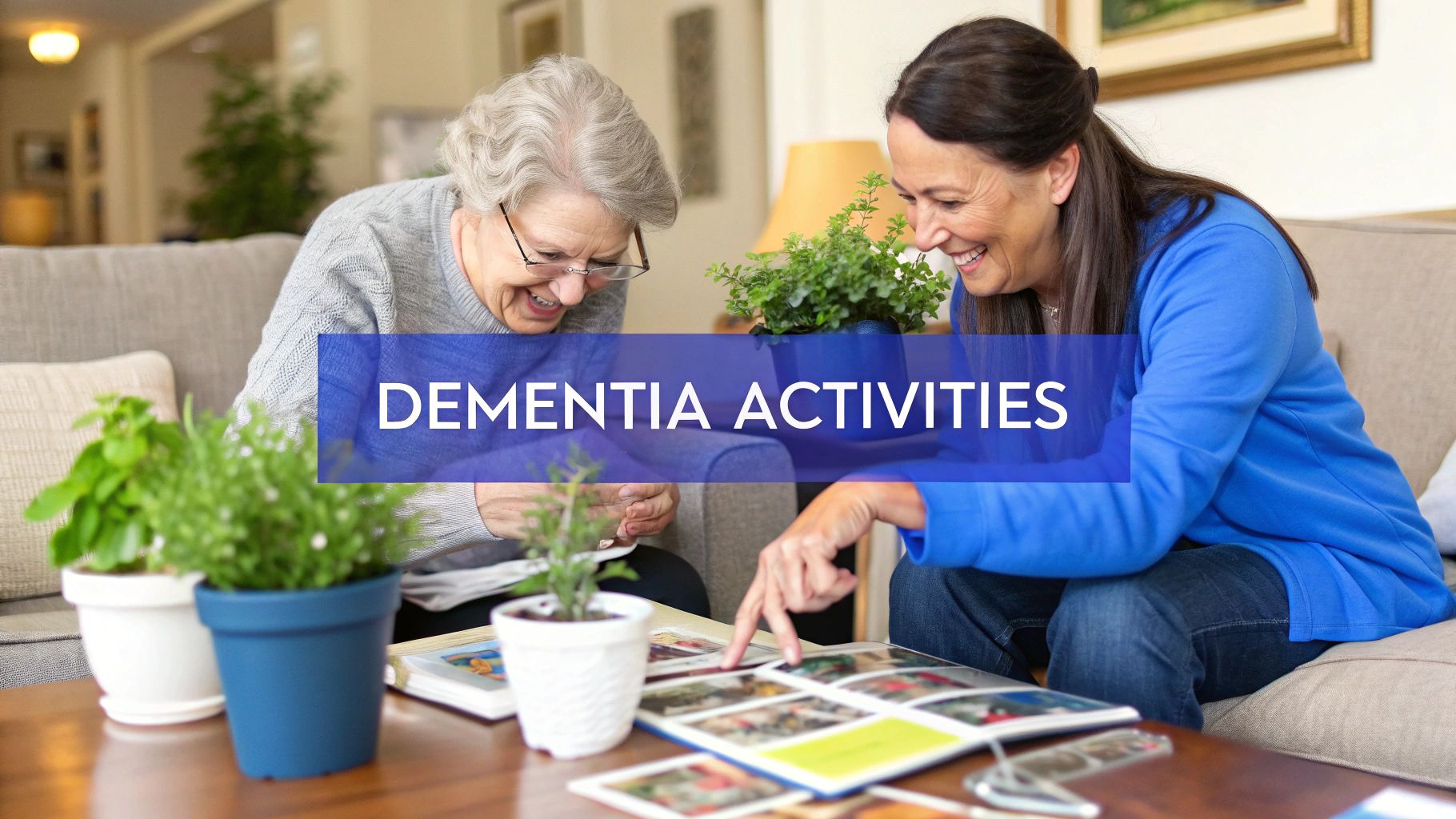Beyond the Basics: Creating Meaningful Moments with Dementia Activities
Finding engaging and appropriate dementia activities for seniors can feel like a constant challenge, but it is one of the most powerful ways to enhance their quality of life. Meaningful engagement helps reduce agitation, provides a sense of purpose, and can even slow cognitive decline. Meaningful activities create opportunities for connection, joy, and non-verbal communication, which become increasingly important as the condition progresses. They reinforce identity and preserve dignity by focusing on remaining abilities rather than limitations.
This guide moves past generic suggestions to provide a detailed list of activities tailored for different stages of dementia. We will explore specific, actionable ideas designed to stimulate the senses, evoke positive memories, and encourage self-expression. You will find practical instructions for implementing each activity, from music and art therapy to simple cooking and gentle exercise. Our goal is to equip you with a diverse toolkit of options that foster connection and create moments of genuine happiness. Each suggestion includes insights on benefits, necessary materials, and tips for adapting the task to an individual’s unique needs and abilities, ensuring a safe and positive experience for everyone involved.
1. Music Therapy and Reminiscence Through Song
Music possesses a unique power to connect with individuals living with dementia, often reaching parts of the brain that other forms of communication cannot. Music therapy and reminiscence use familiar melodies, rhythms, and lyrics to stimulate memories, reduce agitation, and foster positive emotional experiences. This approach leverages the brain's profound and resilient connection to music, which can remain intact even when language and other cognitive abilities have significantly declined.
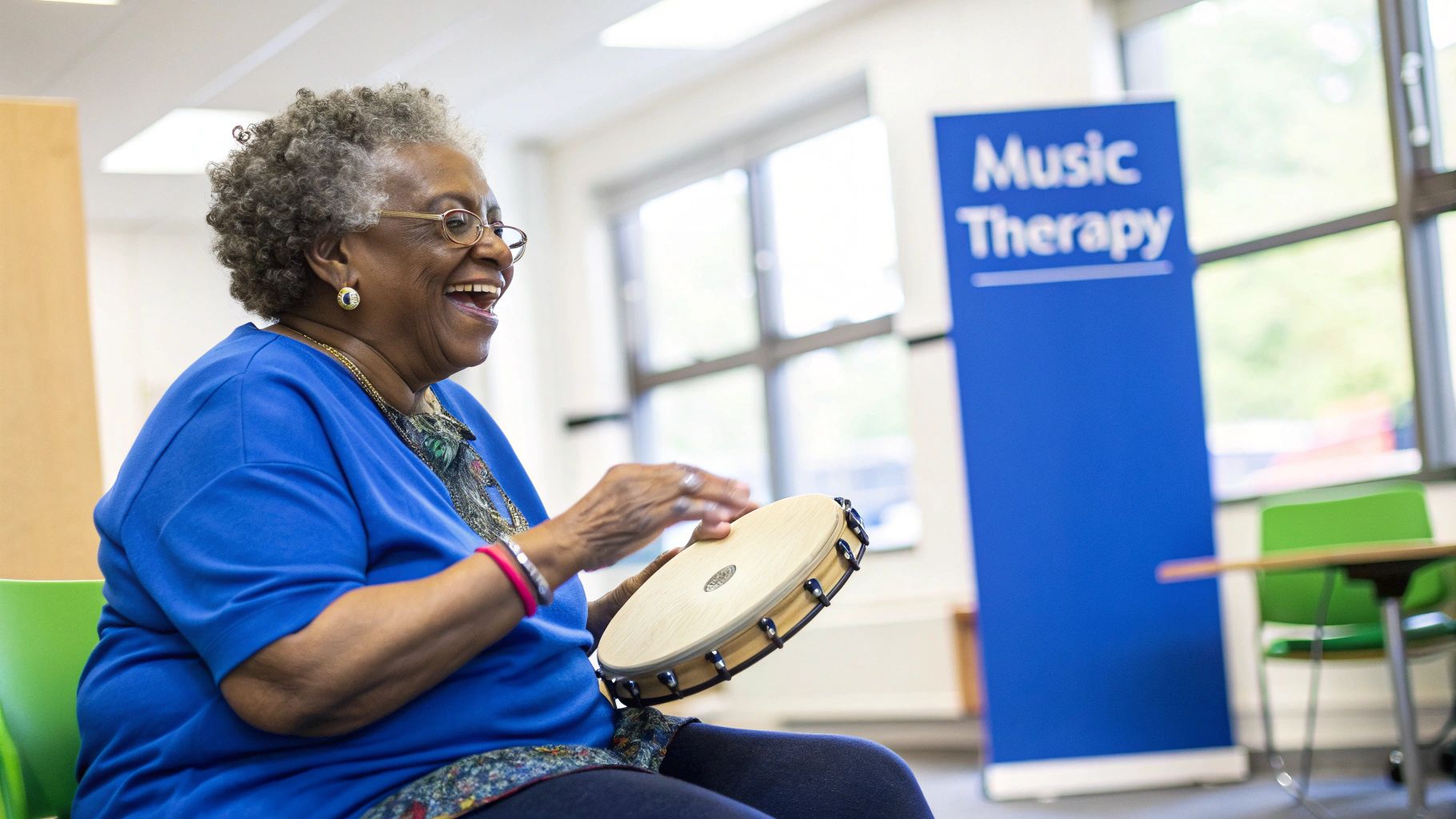
Why It Works for Dementia Care
The connection between music and memory is deeply neurological. As detailed by neurologist Oliver Sacks and programs like Dan Cohen's Music & Memory, musical memories are often stored in areas of the brain that are less affected by dementia. Hearing a song from one's youth can act as a powerful cognitive key, unlocking vivid memories and emotions. This makes music one of the most effective dementia activities for seniors, capable of improving mood, encouraging social interaction, and providing a non-verbal outlet for expression.
How to Implement Music-Based Activities
Creating a successful music-based activity requires personalization and careful observation.
- Create Personalized Playlists: The most impactful music is deeply personal. Build playlists with songs from the senior’s formative years, typically between ages 15 and 25. Include favorite artists, wedding songs, or music associated with important life events.
- Encourage Active Participation: Go beyond passive listening. Provide simple percussion instruments like shakers or tambourines. Encourage clapping, toe-tapping, or even dancing if the person is able. Singing along, even if just humming, is a wonderful way to engage.
- Choose the Right Moment: Use music strategically to ease difficult situations. A calming playlist can reduce anxiety during sundowning, bathing, or mealtimes. Conversely, an upbeat tune can provide a gentle energy boost in the morning.
- Observe and Adapt: Pay close attention to their reaction. A smile, a tapping foot, or singing along are positive signs. If a song seems to cause sadness or distress, gently switch to a different track. The goal is connection and comfort, not forced participation.
2. Sensory Stimulation Activities and Sensory Gardens
Sensory activities engage sight, sound, smell, taste, and touch to provide comfort, calm agitation, and create meaningful connections to the present moment. For individuals with dementia, whose cognitive pathways may be compromised, the senses offer a direct and powerful way to interact with the world. This approach focuses on creating non-verbal, experience-based engagement that can reduce anxiety and ground a person in a safe, soothing environment.
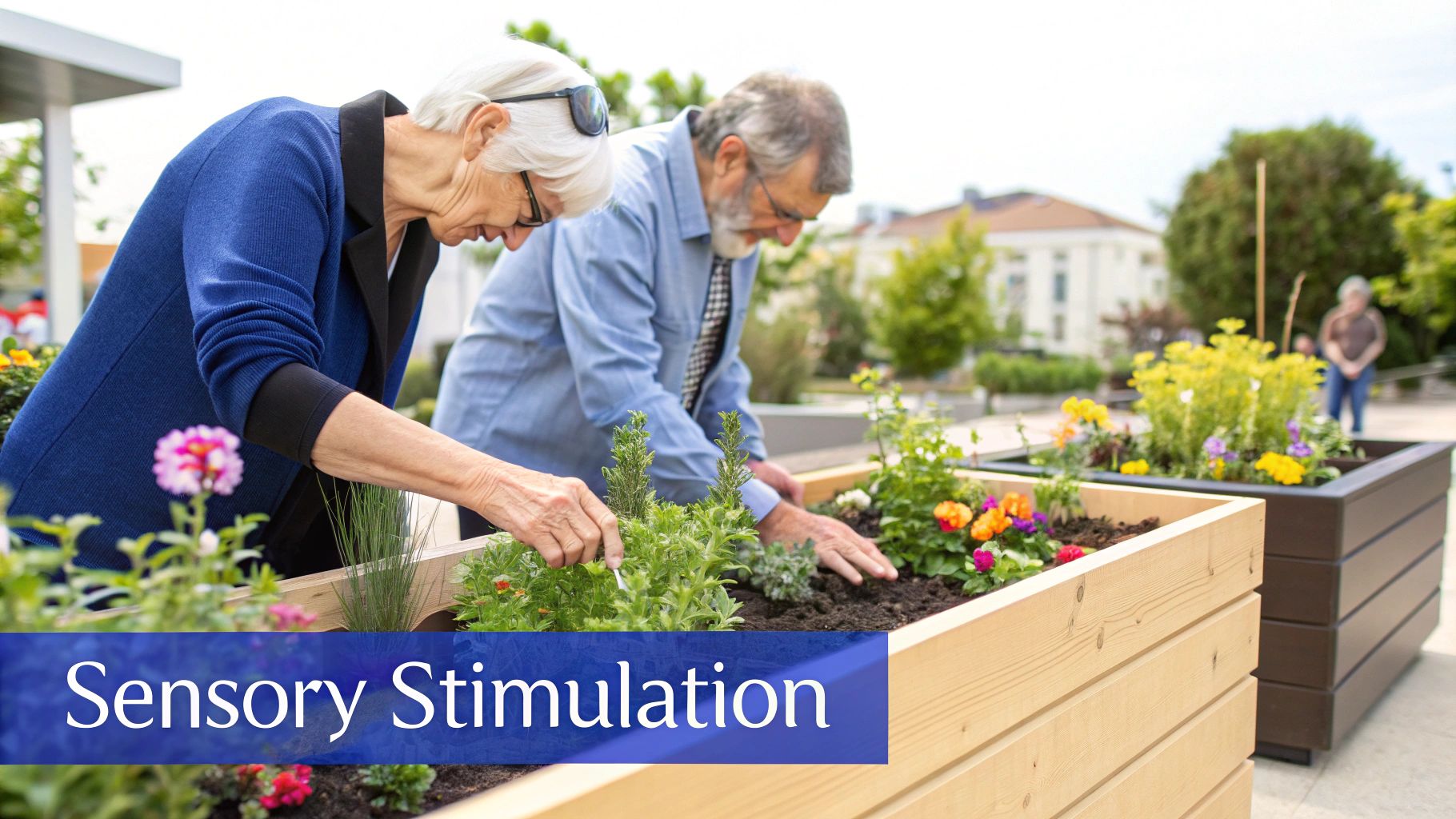
Why It Works for Dementia Care
As dementia progresses, verbal communication can become difficult, leading to frustration and isolation. Sensory stimulation bypasses the need for complex language and cognitive processing, directly accessing the brain's emotional centers. As championed by dementia care specialists like Teepa Snow and organizations such as the Alzheimer's Society, these activities can redirect challenging behaviors, improve mood, and provide a sense of purpose and pleasure. Engaging the senses helps maintain a person's connection to their physical self and surroundings, making it one of the most adaptable and effective dementia activities for seniors across all stages of the condition.
How to Implement Sensory-Based Activities
A successful sensory activity is tailored to the individual’s history and preferences, aiming for comfort and gentle stimulation.
- Develop Tactile Experiences: Provide items with varied textures. This could be a tactile board with zippers, buttons, and different fabrics, or a "Twiddle Muff," a soft, knitted tube with interesting items attached inside and out. Simple activities like folding warm laundry or kneading dough can also be highly effective.
- Utilize Aromatherapy: Scents have a powerful link to memory. Use an essential oil diffuser with calming scents like lavender or uplifting ones like citrus. The smell of baking bread, a familiar perfume, or fresh-cut flowers can also evoke positive feelings and memories.
- Create a Sensory Garden: If space allows, a sensory garden offers a multi-faceted experience. Plant fragrant herbs like mint and rosemary, soft-leafed plants like lamb’s ear, and colorful flowers. Raised beds make gardening more accessible, and the simple act of touching soil and plants can be profoundly therapeutic.
- Observe and Personalize: Always supervise activities, especially with small objects. Pay close attention to reactions, as a particular scent or texture might be overwhelming or unpleasant. The goal is to discover what brings that specific person joy and comfort, rotating items to maintain interest without causing distress.
3. Art Therapy and Creative Expression
Art therapy offers a powerful non-verbal outlet for individuals with dementia, allowing them to express feelings, memories, and ideas when words fail. This therapeutic method involves activities like painting, drawing, sculpting, or creating collages, focusing entirely on the creative process rather than the final product. It provides a sense of purpose and accomplishment, tapping into the creative centers of the brain that may remain strong despite cognitive decline.
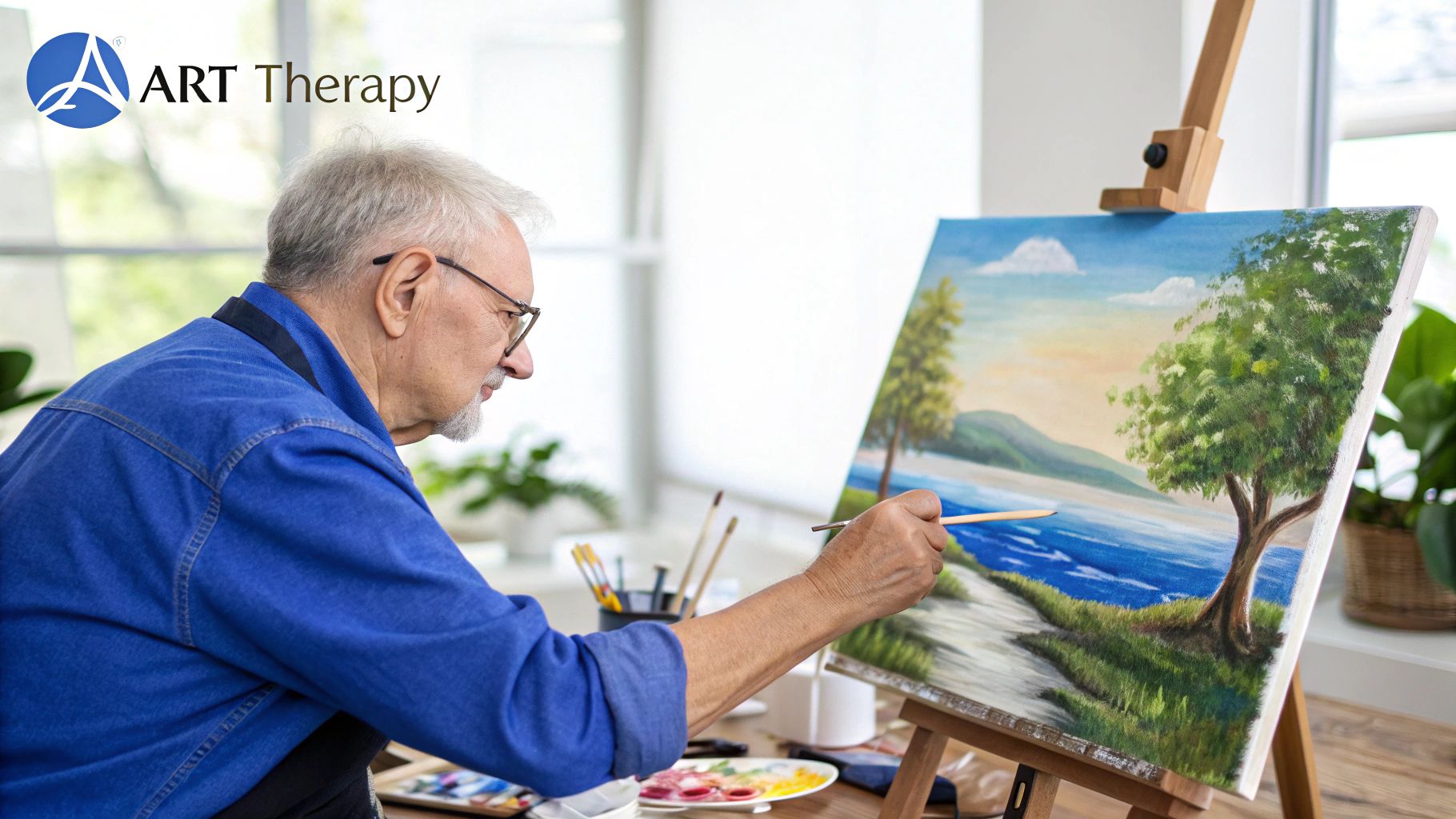
Why It Works for Dementia Care
Creative expression can reduce anxiety, alleviate depression, and redirect challenging behaviors by providing a structured, engaging focus. Programs like the Alzheimer's Association's 'Memories in the Making' and Anne Basting's TimeSlips method demonstrate that art can stimulate the senses and unlock memories. The tactile nature of clay, the visual appeal of color, and the motor skills involved in painting all engage the brain in unique ways. This makes art one of the most versatile dementia activities for seniors, as it can be adapted to any skill level and stage of the condition.
How to Implement Art-Based Activities
Successful art sessions prioritize freedom of expression and are adapted to the individual's abilities.
- Select Safe and Appropriate Materials: Always use non-toxic, washable supplies. For individuals with motor challenges, provide large-handled brushes, chunky crayons, or adaptive tools. Pre-cut shapes for collages can also simplify the process.
- Encourage Self-Expression, Not Perfection: The goal is engagement, not a masterpiece. Provide gentle prompts or themes related to their life history, such as "paint a memory from your childhood garden" or "create a collage of your favorite colors."
- Focus on the Process: Guide the activity by commenting on the process itself. Say things like, "I love the bright blue you're using," or "That looks like fun to work with." This validates their effort and keeps the experience positive.
- Display Their Creations: Celebrate their work by displaying it proudly. This simple act boosts self-esteem and gives the individual a tangible sense of accomplishment and recognition. It reinforces their identity beyond their diagnosis.
4. Reminiscence Therapy and Life Story Work
Reminiscence therapy involves using sensory prompts like photographs, familiar objects, and conversational cues to help individuals with dementia recall and share significant events and experiences from their past. This structured approach to memory sharing validates a person's life experiences, reinforcing their sense of self and identity. By focusing on long-term memories, which often remain more accessible than short-term ones, this activity promotes cognitive engagement and emotional connection.
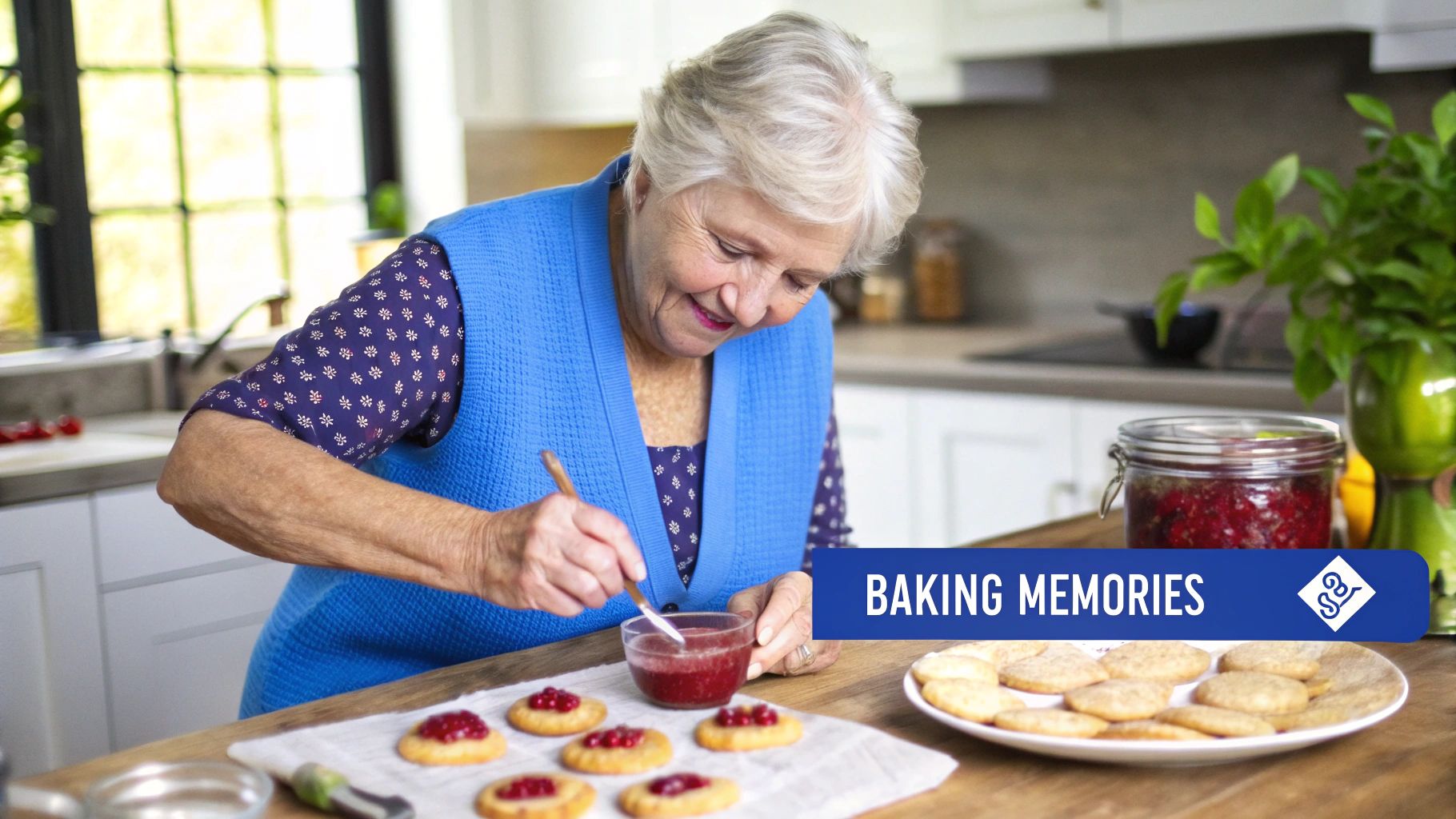
Why It Works for Dementia Care
The effectiveness of reminiscence therapy lies in its ability to tap into well-preserved long-term memories. Pioneered by figures like psychogerontologist Robert Butler, this method helps bridge communication gaps caused by cognitive decline. Sharing stories from their youth or career provides a profound sense of accomplishment and purpose. This makes reminiscence one of the most powerful dementia activities for seniors, as it can reduce feelings of isolation, decrease agitation, and foster meaningful bonds between the individual and their caregivers or family members.
How to Implement Life Story Activities
Creating a successful reminiscence session is about gentle guidance and using tangible prompts to spark memories.
- Create a Memory Box or Book: Gather items related to the person’s life. This could be a box filled with tools from a past trade, photos from their wedding, or souvenirs from a favorite vacation. A physical photo album or scrapbook is also a wonderful, tactile tool.
- Use Open-Ended Questions: Instead of asking "Do you remember this?", try "Tell me about this day" or "What was it like growing up here?". These questions invite storytelling rather than testing memory, reducing potential frustration.
- Focus on Positive Experiences: Guide the conversation toward happy memories, achievements, and proud moments. This helps boost mood and self-esteem. If a distressing memory surfaces, gently acknowledge the feeling and redirect the conversation to a more comforting topic.
- Involve All Senses: Incorporate prompts beyond the visual. Play music from their era, offer a familiar scent like a specific perfume or baking spice, or provide a textured object like a piece of lace or a wooden tool to hold.
5. Simple Cooking and Baking Activities
Cooking and baking are powerful, multi-sensory activities that tap into deeply embedded procedural memories and routines. These activities allow individuals with dementia to engage in a familiar and purposeful task, often triggering positive emotional responses linked to family, tradition, and comfort. The process, from washing vegetables to stirring batter, provides a sense of contribution and accomplishment, reinforcing self-worth and identity.
Why It Works for Dementia Care
The act of preparing food is rich with sensory input, the smell of baking bread, the texture of dough, the sight of colorful ingredients. These stimuli can bypass cognitive deficits and connect directly with emotional and long-term memory centers. Programs like 'Cooking with Memories' have demonstrated how these activities reduce agitation and foster social connection. Because it is a goal-oriented task with a tangible reward, it stands out as one of the most fulfilling dementia activities for seniors, promoting engagement and a sense of normalcy.
How to Implement Cooking-Based Activities
Safety and simplicity are key to creating a positive cooking or baking experience. The focus should always be on the process, not perfection.
- Choose Familiar, Simple Recipes: Opt for recipes that are culturally significant or were family favorites, like making simple sandwiches, kneading dough for bread, mixing a batch of no-bake cookies, or assembling a fruit salad. This familiarity makes the task less intimidating.
- Prioritize Safety and Preparation: Prepare and pre-measure ingredients in advance to reduce complexity. Use safe, adaptive tools and electric appliances like a mixer or slow cooker instead of an open stovetop flame. Ensure the workspace is clear and well-lit.
- Break Down Tasks into Single Steps: Guide the person through one manageable step at a time. For example, say, "First, let's wash the potatoes," and once that is done, move to, "Now, we can peel them." This prevents overwhelm and focuses attention.
- Encourage Storytelling and Sensory Exploration: Use the activity as a prompt for reminiscence. Ask questions like, "Did your mother make a special kind of cake?" or "What does this smell remind you of?" Encourage them to touch, smell, and taste the ingredients, making it a rich sensory journey.
6. Pet Therapy and Animal-Assisted Activities
Pet therapy and animal-assisted activities create opportunities for gentle, non-verbal connection between seniors with dementia and trained animals. This approach harnesses the innate human-animal bond to provide comfort, reduce stress, and stimulate positive social responses. The unconditional, non-judgmental affection offered by an animal can break through communication barriers caused by dementia, creating moments of pure joy and calm.
Why It Works for Dementia Care
The therapeutic benefits of interacting with animals are well-documented. For individuals with dementia, the simple act of stroking a dog’s fur or hearing a cat purr can lower blood pressure, reduce cortisol levels, and trigger the release of endorphins. This sensory engagement is calming and requires no complex cognitive processing, making it one of the most accessible dementia activities for seniors. The presence of an animal can decrease agitation, combat feelings of loneliness, and even prompt reminiscence about past pets, unlocking cherished memories.
How to Implement Animal-Assisted Activities
A safe and positive experience with animals requires careful planning and supervision.
- Partner with Certified Organizations: Connect with reputable groups like Pet Partners or Therapy Dogs International. Their animals are trained, screened, and insured for visiting healthcare environments, ensuring a safe and reliable interaction.
- Supervise All Interactions: A handler should always be present to manage the animal and facilitate gentle engagement. This protects both the senior and the animal, ensuring the experience remains positive for everyone involved. Observe the senior for signs of comfort or distress and adjust accordingly.
- Use Animals as a Catalyst for Conversation: The animal's presence is a natural conversation starter. Ask questions like, "Did you ever have a dog?" or "What do you think her name is?" This can spark memories and encourage social interaction with caregivers and peers.
- Consider Alternatives When Needed: If live animals are not practical due to allergies, facility restrictions, or individual fears, lifelike robotic pets can be a surprisingly effective alternative. These interactive companions mimic the look and feel of real animals and can provide similar benefits of comfort and engagement without the logistical challenges.
7. Gentle Exercise and Movement Programs
Gentle exercise and adapted physical activities are crucial for maintaining the physical and mental well-being of individuals with dementia. These programs, which can include chair yoga, guided walking, or adapted tai chi, focus on preserving mobility, improving balance, and enhancing strength in a safe, supportive environment. Movement stimulates blood flow to the brain, which can help support cognitive function and offers a powerful, non-verbal outlet for expression and enjoyment.
Why It Works for Dementia Care
The mind-body connection is scientifically proven, and physical activity has a direct impact on brain health. As highlighted by research from the National Institute on Aging, regular movement can help reduce anxiety, improve sleep, and may even slow the progression of cognitive decline in some individuals. These structured activities provide routine and a sense of accomplishment. This makes gentle exercise one of the most beneficial dementia activities for seniors, as it addresses physical health, mood regulation, and cognitive stimulation simultaneously.
How to Implement Movement-Based Activities
A successful movement program prioritizes safety, enjoyment, and individual ability over performance.
- Adapt to Individual Capabilities: Not all exercises are suitable for everyone. Offer seated options like chair yoga or seated dancing for those with limited mobility. For others, a supervised walk along a secure path may be ideal. Always tailor the activity to the person's physical condition.
- Focus on Fun and Engagement: Incorporate familiar, upbeat music to create a positive and motivating atmosphere. The goal is joyful participation, not a strenuous workout. Use props like colorful scarves or soft balls to make movements more engaging and playful.
- Establish a Gentle Routine: Consistency is key. A short, 15-20 minute session at the same time each day can become a comforting and anticipated part of the routine. Start slowly and gradually increase duration as tolerated, always watching for signs of fatigue or discomfort.
- Ensure a Safe Environment: Safety is paramount. Ensure the space is free of clutter and hazards. For standing exercises, have sturdy chairs or handrails nearby for support. Always provide close supervision to prevent falls and assist as needed.
7 Dementia Activities Comparison Guide
| Therapy / Activity | Implementation Complexity 🔄 | Resource Requirements ⚡ | Expected Outcomes 📊 | Ideal Use Cases 💡 | Key Advantages ⭐ |
|---|---|---|---|---|---|
| Music Therapy and Reminiscence Through Song | Moderate — requires knowledge of musical preferences and some facilitation | Minimal equipment; simple instruments or playlists | Reduces anxiety, triggers memories, improves mood | Seniors with various dementia stages; group or individual settings | Immediate emotional response; low training needed |
| Sensory Stimulation Activities and Sensory Gardens | Moderate — setup of sensory materials and garden maintenance | Sensory kits or garden spaces; supervision required | Calms agitation, enhances sensory engagement | Non-verbal or agitated individuals; outdoor or indoor | Multi-sensory engagement; adaptable to mobility levels |
| Art Therapy and Creative Expression | Moderate to High — needs art supplies and some facilitation | Art materials and workspace; cleanup assistance | Emotional expression; improves motor skills | Seniors with varied motor ability, expressive therapy | Boosts self-esteem; tangible creative outcomes |
| Reminiscence Therapy and Life Story Work | Moderate — preparation of personal memorabilia and facilitation | Personal photographs, memorabilia, memory books | Enhances identity, mood, social interaction | Individuals with earlier-stage dementia; social groups | Validates history; facilitates communication |
| Simple Cooking and Baking Activities | Moderate — requires supervision and safety precautions | Kitchen tools, ingredients, supervision | Sense of purpose; stimulates appetite and memories | Seniors able to participate in simple tasks; social settings | Engages procedural memory; social and sensory |
| Pet Therapy and Animal-Assisted Activities | Moderate to High — requires certified animals and handlers | Trained therapy animals, handlers, supervision | Reduces agitation; provides companionship | Seniors comfortable with animals; anxiety reduction | Unconditional companionship; promotes social interaction |
| Gentle Exercise and Movement Programs | Moderate to High — needs trained instructors and safety measures | Minimal equipment; music; trained facilitators | Improves mobility, mood, cognition | Seniors with mobility limitations; group or individual | Maintains physical function; may slow cognitive decline |
Integrating Activities for Holistic Dementia Care
Navigating the journey of dementia care requires more than just managing physical needs; it demands a thoughtful and compassionate approach to nurturing the whole person. As we've explored, the right dementia activities for seniors are not just ways to pass the time. They are powerful tools for connection, communication, and preserving a sense of self. From the evocative power of music and the tactile engagement of a sensory garden to the creative release of art therapy, each activity offers a unique pathway to enhance well-being.
The core takeaway is that engagement is the cornerstone of effective dementia care. The activities detailed in this guide, including reminiscence therapy, gentle cooking, pet-assisted interactions, and simple exercises, all work to stimulate the mind, body, and spirit. They provide structure, reduce agitation, and create moments of joy and purpose, which are invaluable for both the individual living with dementia and their caregivers. The key is to adapt, be patient, and focus on the process rather than the outcome.
Actionable Steps for Meaningful Engagement
To truly transform care, it's essential to move from simply knowing about these activities to implementing them effectively. Here are your next steps:
- Create a Personalized "Activity Menu": Review the activities we've discussed. Based on your loved one’s past interests, current abilities, and personality, create a list of 5-10 potential activities. This becomes your go-to resource for daily planning.
- Observe and Adapt: Introduce one new activity at a time. Pay close attention to their reactions. Do they seem engaged, frustrated, or passive? Use these observations to modify the activity. For example, if painting is overwhelming, try simpler coloring pages. If baking is too complex, focus on just one step, like stirring the batter.
- Establish a Gentle Routine: Consistency can be very comforting for someone with dementia. Try to incorporate a short, engaging activity at a similar time each day, such as listening to favorite songs after breakfast or sorting colorful objects in the afternoon. This predictability helps reduce anxiety.
The Lasting Impact of Purposeful Activity
Mastering the art of selecting and implementing dementia activities for seniors is one of the most profound gifts a caregiver can offer. It shifts the focus from what has been lost to what can still be enjoyed. These shared experiences foster a deeper emotional connection, validating the individual's identity and worth beyond their diagnosis. Ultimately, this approach not only improves their quality of life but also enriches the caregiving experience, replacing moments of stress with opportunities for shared humanity and connection.
Finding the right balance of activities and professional support can make all the difference. For families in New Jersey seeking expert, compassionate in-home care tailored to individuals with dementia, NJ Caregiving provides trained professionals who specialize in creating safe, stimulating, and nurturing environments. Our caregivers are skilled in implementing these very activities to promote holistic well-being right at home.

